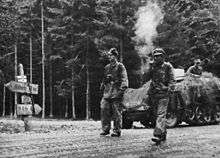Waffen-SS
| Waffen-SS | |
|---|---|
 Waffen-SS in the Baltic states | |
| Active | 1933–45 |
| Country |
|
| Allegiance |
|
| Branch |
|
| Type | |
| Size | 900,000 served in 38 divisions |
| Part of | SS; under operational control of the OKW |
| Garrison/HQ | SS Führungshauptamt, Berlin |
| Engagements | World War II |
| Commanders | |
| Ceremonial chief | Heinrich Himmler |
| Notable commanders | |
The Waffen-SS (German pronunciation: [ˈvafən.ɛs.ɛs], Armed SS) was the armed wing of the Nazi Party's Schutzstaffel (SS, "Protective Squadron"). Its formations included men from Nazi Germany, along with volunteers and conscripts from both occupied and un-occupied lands.[1]
The Waffen-SS grew from three regiments to over 38 divisions during World War II, and served alongside the Heer (regular army) but was never formally part of it.[2] Adolf Hitler resisted integrating the Waffen-SS into the army, as it was intended to remain the armed wing of the Party and to become an elite police force once the war was won.[3] Prior to the war, it was under the control of the SS Führungshauptamt (SS operational command office) beneath Reichsführer-SS Heinrich Himmler. Upon mobilization its tactical control was given to the High Command of the Armed Forces (OKW), but it would also remain a "unit of the NSDAP", according to Hitler.[4]
Initially, in keeping with the racial policy of Nazi Germany, membership was only open to people of Germanic origin (so-called Aryan ancestry).[5] The rules were partially relaxed in 1940, although groups considered by Nazis to be "sub-human" like ethnic Poles or Jews remained excluded.[6][7] Hitler authorized the formation of units composed largely or solely of foreign volunteers and conscripts. Foreign SS units were made up of men mainly from among the nationals of Nazi-occupied Europe.
At the post-war Nuremberg trials the Waffen-SS was condemned as a criminal organisation due to its connection to the Nazi Party and involvement in numerous war crimes. Waffen-SS veterans were denied many of the rights afforded to the military veterans. An exception was made for Waffen-SS conscripts sworn in after 1943, who were exempted because they were not volunteers.
Origins (1929–39)

The origins of the Waffen-SS can be traced back to the selection of a group of 120 SS men in March 1933 by Josef "Sepp" Dietrich to form the Sonderkommando Berlin.[8] By November 1933 the formation had 800 men, and at a remembrance ceremony in Munich for the tenth anniversary of the failed Munich Putsch the regiment swore allegiance to Hitler. The oaths pledged were Pledging loyalty to him alone and Obedience unto death.[8] The formation was given the title Leibstandarte (Bodyguard Regiment) Adolf Hitler (LAH).[9] On 13 April 1934, by order of Himmler, the regiment became known as the Leibstandarte SS Adolf Hitler (LSSAH).[9]
The Leibstandarte demonstrated their loyalty to Hitler in 1934 during the Night of the Long Knives, when the Nazi regime carried out a series of political killings and the purge of the Sturmabteilung (SA).[8] Led by one of Hitler's oldest comrades, Ernst Röhm, the SA was seen as a threat by Hitler to his newly gained political power. Hitler also wanted to conciliate leaders of the Reichswehr and conservatives of the country, people whose support Hitler needed to solidify his position. When Hitler decided to act against the SA, the SS was put in charge of eliminating Röhm and the other high-ranking SA officers.[10] The Night of the Long Knives occurred from between 30 June and 2 July 1934 and saw the killing of approximately 82 SA men, including almost its entire leadership, effectively ending the power of the SA. This action was largely carried out by the Leibstandarte and other SS personnel.[8]
In September 1934, Hitler authorized the formation of the military wing of the Nazi Party and approved the formation of the SS-Verfügungstruppe (SS-VT), a special service troop under Hitler's overall command.[8] The SS-VT had to depend on the German Army for its supply of weapons and military training, and they had control of the recruiting system through local draft boards responsible for assigning conscripts to the different branches of the Wehrmacht to meet quotas set by the German High Command (Oberkommando der Wehrmacht or OKW in German). The SS was given the lowest priority for recruits.[11]
Even with the difficulties presented by the quota system, Heinrich Himmler formed two new SS regiments, the SS Germania and SS Deutschland, which together with the Leibstandarte and a communications unit made up the SS-VT.[11] At the same time Himmler established the SS-Junkerschule Bad Tölz and SS-Junkerschule Braunschweig for military training of SS officers.[11] Both schools used regular army training methods and mainly used former army officers as instructors.[11]
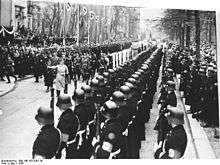
Himmler initially in 1934 set stringent requirements for recruits. They were to be German nationals who could prove their Aryan ancestry back to 1800, unmarried, and without a criminal record.[12] A four-year commitment was required for the SS-VT and LSSAH. Recruits had to be between the ages of 17 and 23, at least 1.74 metres (5 ft 9 in) tall (1.78 metres (5 ft 10 in) for the LSSAH). Concentration camp guards had to make a one-year commitment, be between the ages of 16 and 23, and at least 1.72 metres (5 ft 8 in) tall. All recruits were required to have no dental fillings, 20/20 eyesight and provide a medical certificate.[13] By 1938 the height restrictions were relaxed, up to six dental fillings were permitted, and eyeglasses for astigmatism and mild vision correction were allowed. Once the war commenced, the physical requirements were no longer strictly enforced, and essentially any recruit who could pass a basic medical exam was considered for service.[14] Members of the SS could be of any religion except Judaism (Jewish), but atheists were not allowed according to Himmler in 1937.[15]
The officers of the SS were almost all of lower middle-class or working-class origin, who would have not been considered for commissioning in the old German Army. In the SS they could take part in the gentlemanly rituals of the mess. Fritz Langanke was the son of a miner. Major Heinrich Wulf, commander of the Das Reich reconnaissance battalion, was the son of a North German worker who died as a conscript in Flanders in 1917. Major Gunther-Eberhardt Wisliceny the commander of the Deutschland Panzergrenadier regiment was described as looking like a tall, stiff Prussian Junker, but had been a miner in Silesia for three years. Major Otto Weidinger was the son of a post office worker, and he was rejected by both the army and the police before acceptance into the SS.[16] But some were from the old elite, like Otto Pohl (commander of a tank unit); his father, an officer in the navy, joined Hitler in the 1920s and became a SS General.[17]
In 1936, Himmler selected former Lieutenant General Paul Hausser to be Inspector of the SS-VT with the rank of Brigadefuhrer. Hausser worked to transform the SS-VT into a credible military force that was a match for the regular army.[18][19]
On 17 August 1938, Hitler declared that the SS-VT would have a role in domestic as well as foreign affairs, which transformed this growing armed force into the rival that the army had feared.[20] He decreed that service in the SS-VT qualified to fulfill military service obligations, although service in the SS-Totenkopfverbände or SS-TV would not. Some units of the SS-TV would, in the case of war, be used as reserves for the SS-VT, which did not have its own reserves.[21] For all its training, the SS-VT was untested in combat. In 1938, a battalion of the Leibstandarte was chosen to accompany the army troops in occupying Austria during the Anschluss, and the three regiments of the SS-VT participated in the occupation of the Sudetenland that October. In both actions no resistance was met.[19][21]
Recruiting of ethnic Germans from other countries began in April 1940, and units consisting of non-Germanic recruits were formed beginning in 1942.[22] Non-Germanic units were not considered to be part of the SS, which still maintained its racial criteria, but rather were considered to be foreign nationals serving under the command of the SS.[23]
World War II
1939
Invasion of Poland
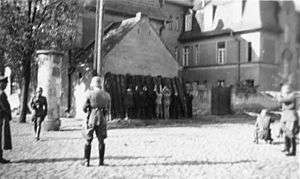
Himmler's military formations at the outbreak of the war comprised several subgroups which would become the basis of the Waffen-SS.
- The Leibstandarte SS Adolf Hitler (LSSAH), under then Obergruppenführer[lower-alpha 1] Josef "Sepp" Dietrich.[24]
- The Inspectorate of Verfügungstruppe (SS-VT), under Gruppenführer Paul Hausser, which commanded the Deutschland, Germania and Der Führer regiments. The latter was recruited in Austria after the Anschluss and was not yet combat-ready.[25]
- The Inspectorate of Concentration Camps, under Gruppenführer Theodor Eicke, which fielded four infantry and one cavalry Death's-Head Standarten, comprising camp guards of the SS-Totenkopfverbände (SS-TV). These troops wore the SS-TV skull and crossbones rather than the SS-VT "SS" runes.[26]
- Police units of Obergruppenführer und General der Polizei Kurt Daluege's Ordnungspolizei, which reported to Himmler in his capacity as Chief of German Police. These troops used police ranks and insignia rather than those of the SS.[27]
In August 1939, Hitler placed the Leibstandarte and the SS-VT under the operational control of the Army High Command (OKH).[25] Himmler retained command of the Totenkopfstandarten, for employment behind the advancing combat units in what were euphemistically called "special tasks of a police nature".[28]
In spite of the swift military victory over Poland in September 1939, the regular army felt that the performance of the SS-VT left much to be desired; its units took unnecessary risks and had a higher casualty rate than the army.[25] They also stated that the SS-VT was poorly trained and its officers unsuitable for combat command. As an example, OKW noted that the Leibstandarte had to be rescued by an army regiment after becoming surrounded at Pabianice by the Poles.[25] In its defence, the SS insisted that it had been hampered by having to fight piecemeal instead of as one formation, and was improperly equipped by the army to carry out its objectives.[25] Himmler insisted that the SS-VT should be allowed to fight in its own formations under its own commanders, while the OKW tried to have the SS-VT disbanded altogether.[25] Hitler was unwilling to upset either the army or Himmler, and chose a third path. He ordered that the SS-VT form its own divisions but that the divisions would be under army command.[25]
During the invasion, war crimes were committed against the Polish people. The Leibstandarte became notorious for torching villages without military justification.[29] Members of the Leibstandarte also committed atrocities in numerous towns, including the murder of 50 Polish Jews in Błonie and the massacre of 200 civilians, including children, who were machine gunned in Złoczew. Shootings also took place in Bolesławiec, Torzeniec, Goworowo, Mława, and Włocławek.[30] Eicke's SS-TV field forces were not military. "Their military capabilities were employed instead in terrorizing the civilian population through acts that included hunting down straggling Polish soldiers, confiscating agricultural produce and livestock, and torturing and murdering large numbers of Polish political leaders, aristocrats, businessmen, priests, intellectuals, and Jews."[31] His Totenkopfverbände troops were called on to carry out "police and security measures" in the rear areas. What these measures involved is demonstrated by the record of SS Totenkopf Standarte "Brandenburg". It arrived in Włocławek on 22 September 1939 and embarked on a four-day "Jewish action" that included the burning of synagogues and the execution en-masse of the leaders of the Jewish community. On 29 September the Standarte travelled to Bydgoszcz to conduct an "intelligentsia action".[32]
First Divisions
In October 1939, Deutschland, Germania, and Der Führer regiments were reorganized into the SS-Verfügungs-Division. The Leibstandarte remained independent and was increased in strength to a reinforced motorized regiment.[25] Hitler authorized the creation of two new divisions: the SS Totenkopf Division, formed from militarized Standarten of the SS-Totenkopfverbände, and the Polizei Division, formed from members of the national police force.[33] Almost overnight the force that the OKW had tried to disband had increased from 18,000 to over 100,000 men.[34] Hitler next authorized the creation in March 1940 of four Motorized Artillery battalions, one for each division and the Leibstandarte. The OKW was supposed to supply these new battalions with artillery, but was reluctant to hand over guns from its own arsenal. The weapons arrived only slowly, and by the time of the Battle of France only the Leibstandarte battalion was up to strength.[35]
1940
France and the Netherlands
The three SS divisions and the Leibstandarte spent the winter of 1939 and the spring of 1940 training and preparing for the coming war in the west. In May they moved to the front, and the Leibstandarte became part of the Army's 227th Infantry Division. The Der Führer Regiment was detached from the SS-VT Division and relocated near the Dutch border, with the remainder of the division behind the line in Münster, awaiting the order to invade the Netherlands. The SS Totenkopf and Polizei Divisions were held in reserve.[36]
On 10 May the Leibstandarte, wearing Dutch uniforms, overcame Dutch border guards to spearhead the German advance into the Netherlands, and the Der Führer advanced towards Utrecht. The following day the rest of the SS-VT Division crossed into the Netherlands and headed towards Rotterdam, which they reached on 12 May.[36] After the surrender of Rotterdam, the Leibstandarte left for the Hague, which they reached on 15 May, capturing 3,500 Dutch as prisoners of war.[37]
In France the SS Totenkopf was involved in the only Allied tank attack in the Battle of France. On 21 May units of the 1st Army Tank Brigade, supported by the 50th (Northumbrian) Infantry Division, took part in the Battle of Arras. The SS Totenkopf was overrun, finding their standard anti-tank gun, the 3.7 cm PaK 36, was no match for the British Matilda tank.[38]
After the Dutch surrender, the Leibstandarte moved south to France on 24 May. Becoming part of the XIX Panzer Corps under the command of General Heinz Guderian, they took up a position 15 miles south west of Dunkirk along the line of the Aa Canal, facing the Allied defensive line near Watten.[37] A patrol from the SS-VT Division crossed the canal at Saint-Venant, but was destroyed by British armor. A larger force from the SS-VT Division then crossed the canal and formed a bridgehead at Saint-Venant; 30 miles from Dunkirk.[37] That night the OKW ordered the advance to halt, with the British Expeditionary Force trapped. The Leibstandarte paused for the night. However, on the following day, in defiance of Hitler's orders, Dietrich ordered his III Battalion to cross the canal and take the heights beyond, where British artillery observers were putting the regiment at risk. They assaulted the heights and drove the observers off. Instead of being censured for his act of defiance, Dietrich was awarded the Knight's Cross of the Iron Cross.[39] On that same day, British forces attacked Saint-Venant, forcing the SS-VT Division to retreat and relinquish ground.[37]
On 26 May the German advance resumed. On 27 May the Deutschland regiment of the SS-VT Division reached the allied defensive line on the Leie River at Merville. They forced a bridgehead across the river and waited for the SS Totenkopf Division to arrive to cover their flank. What arrived first was a unit of British tanks, which penetrated their position. The SS-VT managed to hold on against the British tank force, which got to within 15 feet of commander Felix Steiner's position. Only the arrival of the Totenkopf Panzerjäger platoon saved the Deutschland from being destroyed and their bridgehead lost.[40]
That same day, as the SS Totenkopf Division advanced near Merville, they encountered stubborn resistance from British Army units which slowed their advance.[40] The SS Totenkopf 4 Company, then committed the Le Paradis massacre, where 97 captured men of the 2nd Battalion, Royal Norfolk Regiment were machine gunned after surrendering, with survivors finished off with bayonets. Two men survived.[41][42]
By 28 May the Leibstandarte had taken the village of Wormhout, only ten miles from Dunkirk.[37] After their surrender, soldiers from the 2nd Battalion, Royal Warwickshire Regiment, along with some other units (including French soldiers) were taken to a barn in La Plaine au Bois near Wormhout and Esquelbecq. It was there that troops of the Leibstandarte 2nd Battalion committed the Wormhoudt massacre, where 80 British and French prisoners of war were killed.[43][44]
By 30 May the British were cornered at Dunkirk, and the SS divisions continued the advance into France. The Leibstandarte reached Saint-Étienne, 250 miles south of Paris, and had advanced further into France than any other unit.[45] By the next day the fighting was all but over.[46] German forces arrived in Paris unopposed on 14 June and France formally surrendered on 25 June. Hitler expressed his pleasure with the performance of the Leibstandarte in the Netherlands and France, telling them, "Henceforth it will be an honour for you, who bear my name, to lead every German attack."[45]
1940 expansion
Himmler gained approval for the Waffen-SS to form its own high command, the Kommandoamt der Waffen-SS within the SS-Führungshauptamt, which was created in August 1940.[47] It received command of the SS-VT (the Leibstandarte and the Verfügungs-Division, renamed Reich) and the armed SS-TV regiments (the Totenkopf-Division together with several independent Totenkopf-Standarten).[48]
In 1940 SS chief of staff Gottlob Berger approached Himmler with a plan to recruit volunteers in the conquered territories from the ethnic German and Germanic populations. At first Hitler had doubts about recruiting foreigners, but he was persuaded by Himmler and Berger.[49] He gave approval for a new division to be formed from foreign nationals with German officers. By June 1940, Danish and Norwegian volunteers had formed the SS Regiment Nordland, with Dutch and Flemish volunteers forming the SS Regiment Westland. The two regiments, together with Germania (transferred from the Reich Division), formed the SS Division Wiking.[50] A sufficient number of volunteers came forward requiring the SS to open a new training camp just for foreign volunteers at Sennheim in Alsace-Lorraine.[50]
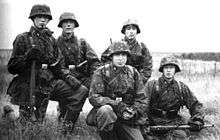
1941
At the beginning of the new year the Polizei-Division was brought under FHA administration, although it would not be formally merged into the Waffen-SS until 1942. At the same time the Totenkopf-Standarten, aside from the three constituting the TK-Division, lost their Death's Head designation and insignia and were reclassified SS-Infanterie- (or Kavallerie-) Regimente. The 11th Rgt. was transferred into the Reich Division to replace Germania; the remainder were grouped into three independent brigades and a battle group in Norway.
By the spring of 1941 the Waffen-SS consisted of the equivalent of six or seven divisions: the Reich, Totenkopf, Polizei, and Wiking Divisions and Kampfgruppe (later Division) Nord, and the Leibstandarte, 1 SS Infantry, 2 SS Infantry, and SS Cavalry Brigades.
Balkans
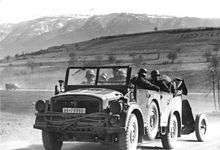
In March 1941, a major Italian counterattack against Greek forces failed, and Germany was forced to come to the aid of its ally. Operation Marita began on 6 April 1941, with German troops invading Greece through Bulgaria and Yugoslavia in an effort to secure its southern flank.[51]
Reich was ordered to leave France and head for Romania, and the Leibstandarte was ordered to Bulgaria. The Leibstandarte, attached to the XL Panzer Corps, advanced west then south from Bulgaria into the mountains, and by 9 April had reached Prilep in Yugoslavia, 30 miles from the Greek border.[52] Further north the SS Reich, with the XLI Panzer Corps, crossed the Romanian border and advanced on Belgrade, the Yugoslav capital. Fritz Klingenberg, a company commander in the Reich, led his men into Belgrade, where a small group in the vanguard accepted the surrender of the city on 13 April. A few days later the Royal Yugoslav Army surrendered.[53][54]
The Leibstandarte had now crossed into Greece, and on 10 April engaged the 6th Australian Division in the Battle of the Klidi Pass. For 48 hours they fought for control of the heights, often engaging in hand-to-hand combat, eventually gaining control with the capture of Height 997, which opened the pass and allowed the German Army to advance into the Greek interior.[55] This victory finally gained praise from the OKW: in the order of the day they were commended for their "unshakable offensive spirit" and told that "the present victory signifies for the Leibstandarte a new and imperishable page of honour in its history."[55]
The Leibstandarte continued the advance on 13 May. When the Reconnaissance Battalion under the command of Kurt Meyer came under heavy fire from the Greek Army defending the Klisura Pass, they broke through the defenders and captured 1,000 prisoners of war at the cost of six dead and nine wounded.[55] The next day, Meyer captured Kastoria and took another 11,000 prisoners of war. By 20 May the Leibstandarte had cut off the retreating Greek Army at Metsovon and accepted the surrender of the Greek Epirus-Macedonian Army.[55] As a reward, the Leibstandarte was nominally promoted to a full motorized division, although few additional elements had been added by the start of the Russian campaign and the "Division" remained effectively a reinforced brigade.
Soviet Union
Operation Barbarossa, the German invasion of the Soviet Union, started on 22 June 1941, and all the Waffen-SS formations participated (including the SS Reich, which was formally renamed to SS Das Reich by the Fall of 1941).[56]
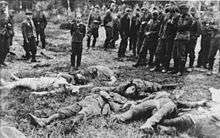
SS Division Nord in northern Finland took part in Operation Arctic Fox with the Finnish Army and fought at the disastrous battle of Salla, where against strong Soviet forces they suffered 300 killed and 400 wounded in the first two days of the invasion. Thick forests and heavy smoke from forest fires disoriented the troops and the division's units completely fell apart.[57] By the end of 1941, Nord had suffered severe casualties. Over the winter of 1941–42 it received replacements from the general pool of Waffen-SS recruits, who were supposedly younger and better trained than the SS men of the original formation, which had been drawn largely from Totenkopfstandarten of Nazi concentration camp guards.
The rest of the Waffen-SS divisions and brigades fared better. The SS Totenkopf and Polizei divisions were attached to Army Group North, with the mission to advance through the Baltic states and on to Leningrad.[19][58] The SS Division Das Reich was with Army Group Centre and headed towards Moscow.[19][58] The SS Division Wiking and the Leibstandarte were with Army Group South, heading for the Ukraine and the city of Kiev.[19][58]
The war in the Soviet Union proceeded well at first, but the cost to the Waffen-SS was extreme: by late October the Leibstandarte was at half strength due to enemy action and dysentery that swept through the ranks.[59] Das Reich lost 60% of its strength and was still to take part in the Battle of Moscow. The unit was decimated in the following Soviet offensive. The Der Führer Regiment was reduced to 35 men out of the 2,000 that had started the campaign in June.[59] Altogether, the Waffen-SS had suffered 43,000 casualties.[59]
While the Leibstandarte and the SS divisions were fighting in the front line, behind the lines it was a different story. The 1 SS Infantry and 2 SS Infantry Brigades, which had been formed from surplus concentration camp guards of the SS-TV, and the SS Cavalry Brigade moved into the Soviet Union behind the advancing armies. At first they fought Soviet partisans and cut off units of the Red Army in the rear of Army Group South, capturing 7,000 prisoners of war, but from mid-August 1941 until late 1942 they were assigned to the Reich Main Security Office headed by Reinhard Heydrich.[57][60] The brigades were now used for rear area security and policing, and were no longer under army or Waffen-SS command. In the Autumn of 1941, they left the anti-partisan role to other units and actively took part in the Holocaust. While assisting the Einsatzgruppen, they participated in the extermination of the Jewish population of the Soviet Union, forming firing parties when required. The three brigades were responsible for the murder of tens of thousands by the end of 1941.[60]
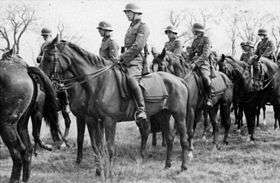
Because it was more mobile and better able to carry out large-scale operations, the SS Cavalry Brigade had 2 regiments with a strength of 3500 men and played a pivotal role in the transition to the wholesale extermination of the Jewish population.[61] In the summer of 1941, Himmler assigned Hermann Fegelein to be in charge of both regiments.[62] On 19 July 1941 Himmler assigned Fegelein's regiments to the general command of HSSPF Erich von dem Bach-Zelewski for the "systematic combing" of the Pripyat swamps, an operation designed to round up and exterminate Jews, partisans, and civilians in that area of Byelorussian SSR.[63]
Fegelein split the territory to be covered into two sections divided by the Pripyat River, with the 1st Regiment taking the northern half and the 2nd Regiment the south.[64] The regiments worked their way from east to west through their assigned territory, and filed daily reports on the number of people killed and taken prisoner. By 1 August the SS Cavalry Regiment 1 under the command of Gustav Lombard was responsible for the death of 800 people; by 6 August, this total had reached 3,000 "Jews and partisans".[65] Throughout the following weeks, personnel of SS Cavalry Regiment 1 under Lombard's command murdered an estimated 11,000 Jews and more than 400 dispersed soldiers of the Red Army.[66] Thus Fegelein's units were among the first in the Holocaust to wipe out entire Jewish communities.[67] Fegelein's final operational report dated 18 September 1941, states that they killed 14,178 Jews, 1,001 partisans, 699 Red Army soldiers, with 830 prisoners taken and losses of 17 dead, 36 wounded, and 3 missing.[68][69] Historian Henning Pieper estimates the actual number of Jews killed was closer to 23,700.[70]
1942
1942 expansion
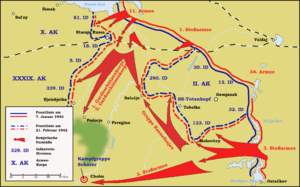
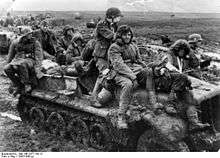
In 1942, the Waffen-SS was further expanded and a new division was entered on the rolls in March. By the second half of 1942 an increasing number of foreigners, many of whom were not volunteers, began entering the ranks.[71] The 7th SS Volunteer Mountain Division Prinz Eugen was recruited from Volksdeutsche (ethnic Germans) drafted under threat of punishment by the local German leadership[71] from Croatia, Serbia, Hungary, and Romania and used for anti-partisan operations in the Balkans.[57][72] Himmler approved the introduction of formal compulsory service for the Volksdeutsche in German occupied Serbia.[71] Another new division was formed at the same time, when the SS Cavalry Brigade was used as the cadre in the formation of the 8th SS Cavalry Division Florian Geyer.[57]
Panzergrenadier divisions
The front line divisions of the Waffen-SS that had suffered losses through the winter of 1941–1942 and during the Soviet counter-offensive were withdrawn to France to recover and be reformed as Panzergrenadier divisions.[73] Thanks to the efforts of Himmler and Obergruppenführer Paul Hausser, the new commander of the SS Panzer Corps, the three SS Panzergrenadier divisions Leibstandarte, Das Reich, and Totenkopf were to be formed with a full regiment of tanks rather than only a battalion. This meant that the SS Panzergrenadier divisions were full-strength Panzer divisions in all but name. They each received nine Tiger tanks, which were formed into the heavy panzer companies.[73]
Demyansk Pocket
The Soviet offensive of January 1942 trapped a number of German divisions in the Demyansk Pocket between February and April 1942; the 3rd SS Totenkopf was one of the divisions encircled by the Red Army. The Red Army liberated Demyansk on 1 March 1943 with the retreat of the German troops. "For his excellence in command and the particularly fierce fighting of the Totenkopf", Obergruppenführer Theodor Eicke was awarded the Oak Leaves to the Knight's Cross on 20 May 1942.[74]
1943
1943 expansion
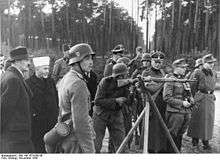
The Waffen-SS expanded further in 1943: in February the 9th SS Panzer Division Hohenstaufen and its sister division, the 10th SS Panzer Division Frundsberg, were formed in France. They were followed in July by the 11th SS Volunteer Panzergrenadier Division Nordland created from Norwegian and Danish volunteers. September saw the formation of the 12th SS Panzer Division Hitlerjugend using volunteers from the Hitler Youth. Himmler and Berger successfully appealed to Hitler to form a Bosnian Muslim division, and the 13th Waffen Mountain Division of the SS Handschar (1st Croatian), the first non-Germanic division, was formed, to fight Josip Broz Tito's Yugoslav Partisans. This was followed by the 14th Waffen Grenadier Division of the SS (1st Galician) formed from volunteers from Galicia in western Ukraine. The 15th Waffen Grenadier Division of the SS (1st Latvian) was created in 1943, using compulsory military service in the Ostland. The final new 1943 division was the 16th SS Panzergrenadier Division Reichsführer-SS, which was created using the Sturmbrigade Reichsführer SS as a cadre. By the end of the year, the Waffen-SS had increased in size from eight divisions and some brigades to 16 divisions.
Kharkov
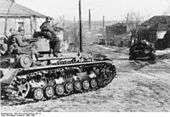
On the Eastern Front, the Germans suffered a devastating defeat when the 6th Army was defeated during the Battle of Stalingrad. Hitler ordered the SS Panzer Corps back to the Eastern Front for a counter-attack with the city of Kharkiv as its objective.[75] The SS Panzer Corps was in full retreat on 19 February, having been attacked by the Soviet 6th Army, when they received the order to counter-attack.[75] In an example of an SS Commander disobeying Hitler's order to "stand fast and fight to the death", Hausser withdrew in front of the Red Army. During Manstein's counteroffensive, the SS Panzer Corps, without support from the Luftwaffe or neighbouring German formations, broke through the Soviet line and advanced on Kharkiv.[76] Despite orders to encircle Kharkiv from the north, the SS Panzer Corps directly attacked in the Third Battle of Kharkov on 11 March.[77] This led to four days of house-to-house fighting before Kharkov was recaptured by the 1 SS Leibstandarte on 15 March. Two days later the Germans recaptured Belgorod, creating the salient that in July 1943 led to the Battle of Kursk. The German offensive cost the Red Army an estimated 70,000 casualties but the house-to-house fighting in Kharkiv was particularly bloody for the SS Panzer Corps, which lost approximately 44% of its strength by the time operations ended in late March.[78]
Warsaw Ghetto uprising
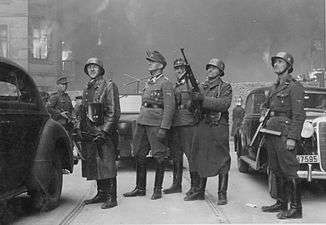
The Warsaw Ghetto Uprising was a Jewish insurgency that arose within the Warsaw Ghetto from 19 April to 16 May, an effort to prevent the transportation of the remaining population of the ghetto to Treblinka extermination camp. Units involved from the Waffen-SS were 821 Waffen-SS Panzergrenadiers from five reserve and training battalions and one cavalry reserve and training battalion.[79][80]
Kursk
The next test for the Waffen-SS was the Battle of Prokhorovka, which was part of the Battle of Kursk. The SS Panzer Corps had been renamed the II SS Panzer Corps and was part of the 4th Panzer Army, which was chosen to spearhead the attack through the Soviet defenses. The attack penetrated to a depth of 35 kilometres (22 mi) and was then stopped by the Soviet 1st Tank Army.
The Soviet reserves had been sent south to defend against a German attack by the III Panzer Corps. With the loss of their reserves, any hope they may have had of dealing a major defeat to the SS Panzer Corps ended. But the German advances now failed – despite appalling losses, the Soviet tank armies held the line and prevented the II SS Panzer Corps from making the expected breakthrough.[81]
.jpg)
While the exact losses on each side cannot be established precisely, the outcome is clearer. Neither the Fifth Guards Tank Army nor the II SS Panzer Corps accomplished their objectives that day. The sudden attack by strong Soviet army reserves and the need to break off the assault by the German 9th Army on the northern shoulder of the Kursk salient due to Operation Kutuzov contributed to Hitler's decision to halt the attack. A parallel attack by the Red Army against the new 6th Army on the Mius river south of Kharkov necessitated the withdrawal of reserve forces held to exploit any success on the southern shoulder of Kursk. The OKW also had to draw on some German troops from the Eastern Front to bolster the Mediterranean theatre following the Anglo-American Invasion of Sicily.[82] On 17 July Hitler called off the operation and ordered a withdrawal.[83] The Soviet Union was not beaten, and the strategic initiative had swung to the Red Army. The Germans were forced onto the defensive as the Red Army began the liberation of Western Russia.[84]
Italy
The Leibstandarte was thereafter sent to Italy to help stabilise the situation there caused by the deposal of Benito Mussolini by the Badoglio government and the Allied Sicily invasion, which was the beginning of the Italian Campaign. The division left behind its armour and equipment, which was given to Das Reich and Totenkopf.[85] After the Italian surrender and collapse of 8 September 1943, the Leibstandarte was ordered to begin disarming nearby Italian units.[85] It also had the task of guarding vital road and rail junctions in the north of Italy and was involved in several skirmishes with partisans.[85] This went smoothly, with the exception of a brief skirmish with Italian troops stationed in Parma on 9 September. By 19 September all Italian forces in the Po River plain had been disarmed, but the OKW received reports that elements of the Italian Fourth Army were regrouping in Piedmont, near the French border. Joachim Peiper's mechanised III Battalion, SS Panzergrenadier Regiment 2, was sent to disarm these units.[85] On arriving in the province of Cuneo, Peiper was met by an Italian officer who warned that his forces would attack unless Peiper's unit vacated the province immediately. After Peiper refused, the Italians attacked. Peiper's battalion defeated the Italians, and subsequently shelled and burnt down the village of Boves, killing at least 34 civilians.[86] Peiper's battalion then disarmed the remaining Italian forces in the area.
While the Leibstandarte was operating in the north, the 16 SS Reichsführer-SS sent a Kampfgruppe to contain the Anzio landings in January 1944. In March, the bulk of the 1st Italienische Freiwilligen Sturmbrigade (or Brigata d'Assalto, Volontari in Italian) was sent to the Anzio beachhead, where they fought alongside their German allies, receiving favourable reports and taking heavy losses. In recognition of their performance, Himmler declared the unit to be fully integrated into the Waffen-SS.
1944
1944 expansion

The Waffen-SS expanded again during 1944. January saw the formation of the 19th Waffen Grenadier Division of the SS (2nd Latvian), formed from the two SS Infantry Brigades as cadre with Latvian conscripts. The 20th Waffen Grenadier Division of the SS (1st Estonian) was formed via general conscription in February 1944, around a cadre from the 3 Estonian SS Volunteer Brigade. The 21st Waffen Mountain Division of the SS Skanderbeg (1st Albanian) was formed in March 1944 from Albanian and Kosovan volunteers, which as with other "eastern formations" were intended for use against "irregular forces".[88] A second Waffen-SS cavalry division followed in April 1944, the 22nd SS Volunteer Cavalry Division Maria Theresia. The bulk of the troops were Hungarian Army Volksdeutsche conscripts transferred to the Waffen-SS following an agreement between Germany and Hungary. The 23rd SS Volunteer Panzer Grenadier Division Nederland followed, formed from the 4th SS Volunteer Panzergrenadier Brigade Nederland, but it was never more than a large brigade. The 24th Waffen Mountain Division of the SS Karstjäger was another division that was never more than brigade size, consisting mainly of ethnic German volunteers from Italy and Yugoslavia, along with volunteers from Slovenia, Croatia, Serbia, and Ukraine. They were primarily involved in fighting partisans in the Kras region of the Alps on the frontiers of Slovenia, Italy, and Austria, the mountainous terrain requiring specialized mountain troops and equipment.[89] Two Hungarian divisions followed: the 25th Waffen Grenadier Division of the SS Hunyadi (1st Hungarian) and the 26th Waffen Grenadier Division of the SS (2nd Hungarian). These were formed under the authority of the Hungarian defense minister, at the request of Himmler. One regiment from the Hungarian Army was ordered to join, but they mostly consisted of Hungarian and Romanian volunteers.[90]
The SS Division Langemarck was formed next in October 1944, from Flemish volunteers added to the 6th SS Volunteer Sturmbrigade Langemarck, but again it was nothing more than a large brigade. The 5th SS Volunteer Sturmbrigade Wallonien was also upgraded to the SS Division Wallonien, but it too was never more than a large brigade. Plans to convert the Kaminnski Brigade into the 29th Waffen Grenadier Division of the SS RONA (1st Russian) were dropped after the execution of their commander, Bronislav Kaminski; instead the Waffen Grenadier Brigade of SS (Italian no. 1) became the 29th Waffen Grenadier Division of the SS (1st Italian). The 30th Waffen Grenadier Division of the SS (2nd Russian) was formed from the Schutzmannschaft-Brigade Siegling. The final new division of 1944, was the 31st SS Volunteer Grenadier Division, formed from conscripted Volksdeutsche, mainly from the Batschka region of Hungary.
Korsun-Cherkassy Pocket
The Korsun-Cherkassy Pocket was formed in January 1944 when units of the 8th Army withdrew to the Panther-Wotan Line, a defensive position along the Dnieper River in Ukraine. Two army corps were left holding a salient into the Soviet lines extending some 100 kilometres (62 mi). The Red Army deployed the 1st and 2nd Ukrainian Fronts to form two armoured rings around the pocket, with an inner ring and an external ring to prevent relief formations from reaching the trapped units. Trapped in the pocket were a total of six German divisions, including the 5 SS Wiking, with the attached 5th SS Volunteer Sturmbrigade Wallonien, and the Estonian SS Battalion Narwa.[91] The Germans broke out in coordination with other German forces from the outside, including the 1 SS Leibstandarte. Roughly two out of three encircled men successfully escaped the pocket.[92]
Raid on Drvar
The Raid on Drvar, codenamed Operation Rösselsprung, was an attack by the Waffen-SS and Luftwaffe on the command structure of the Yugoslav partisans. Their objective was the elimination of the partisan-controlled Supreme Headquarters and the capture of Tito. The offensive took place in April and May 1944. The Waffen-SS units involved were the 500th SS Parachute Battalion and the 7 SS Prinz Eugen.
The assault started when a small group parachuted into Drvar to secure landing grounds for the following glider force. The 500th SS Parachute Battalion fought their way to Tito's cave headquarters and exchanged heavy gunfire resulting in numerous casualties on both sides. By the time German forces had penetrated into the cave, Tito had already escaped. At the end of the battle only 200 men of the 500th SS Parachute Battalion remained unwounded.[93]
Baltic states
In the Baltic states the Battle of Narva started in February. The battle can be divided into two phases: the Battle for Narva Bridgehead from February to July and the Battle of Tannenberg Line from July to September. A number of volunteer and conscript Waffen-SS units from Norway, Denmark, the Netherlands, Belgium, and Estonia fought in Narva. The units were all part of the III SS (Germanic) Panzer Corps in Army Group North, which consisted of the 11th SS Panzergrenadier Division Nordland, the 4th SS Volunteer Panzergrenadier Brigade Nederland, the 5th SS Volunteer Sturmbrigade Wallonien, the 6th SS Volunteer Sturmbrigade Langemarck, and the conscript 20th Waffen Grenadier Division of the SS (1st Estonian), under the command of Obergruppenführer Felix Steiner.[94]
Also in Army Group North was the VI SS Corps, which consisted of the 15th Waffen Grenadier Division of the SS (1st Latvian) and the 19th Waffen Grenadier Division of the SS (2nd Latvian). Latvian Waffen SS and German army units held out in the Courland Pocket until the end of the war.
Normandy

Operation Overlord, the Allied "D-Day" landings in Normandy, took place on 6 June 1944. In preparation for the expected landings the I SS Panzer Corps Leibstandarte SS Adolf Hitler was moved to Septeuil to the west of Paris in April 1944. The Corps had the 1 SS Leibstandarte SS Adolf Hitler, 12 SS Hitlerjugend, the 17 SS Götz von Berlichingen and the Army's Panzer-Lehr-Division divisions assigned to it.[95] The corps was to form a part of General Leo Geyr von Schweppenburg's Panzer Group West, the Western theatre's armoured reserve.[95] The Corps was restructured on 4 July 1944 and only the 1 SS Leibstandarte and the 12 SS Hitlerjugend remained at strength.[96]
After the landings, the first Waffen-SS unit in action was the 12 SS Hitlerjugend, which arrived at the invasion front on 7 June, in the Caen area. The same day they committed the Ardenne Abbey massacre.[97] The next unit to arrive was the 17 SS Götz von Berlichingen on 11 June, which came into contact with the 101st Airborne Division.[98] The SS Heavy Panzer Battalion 101 arrived next to protect the left wing of the I SS Panzer Corps. The 1 SS Leibstandarte arrived towards the end of the month with lead elements becoming embroiled in the British offensive Operation Epsom.
The only other Waffen-SS unit in France at this time was the 2 SS Das Reich, in Montauban, north of Toulouse. They were ordered north to the landing beaches and on 9 June were responsible for the Tulle massacre, where 99 men were murdered. The next day they reached Oradour-sur-Glane and massacred 642 French civilians.
The II SS Panzer Corps consisting of the 9th SS Hohenstaufen and 10th SS Frundsberg divisions and the SS Heavy Panzer Battalion 102 was transferred from the Eastern Front to spearhead an offensive to destroy the Allied beachhead. However, the British launched Operation Epsom and the two divisions were fed piecemeal into the battle, and launched several counterattacks over the following days.
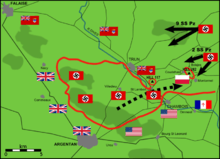
Without any further reinforcements in men or materiel, the Waffen-SS divisions could not stop the Allied advance. 1 SS Leibstandarte and 2 SS Das Reich took part in the failed Operation Lüttich in early August.[99] The end came in mid August when the German Army was encircled and trapped in the Falaise pocket, including the 1 SS Leibstandarte, 10 SS Frundsberg and 12 SS Hitlerjugend and the 17 SS Götz von Berlichingen, while the 2 SS Das Reich and the 9 SS Hohenstaufen were ordered to attack Hill 262 from the outside in order to keep the gap open.[100] By 22 August the Falaise pocket had been closed, and all German forces west of the Allied lines were dead or in captivity.[101] In the fighting around Hill 262 alone, casualties totalled 2,000 killed and 5,000 taken prisoner.[102] The 12 SS Hitlerjugend had lost 94 per cent of its armour, nearly all of its artillery, and 70 per cent of its vehicles.[103] The division had close to 20,000 men and 150 tanks before the campaign started, and was now reduced to 300 men and 10 tanks.[103]
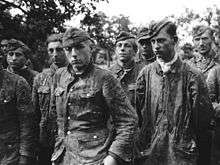
With the German Army in full retreat, two further Waffen-SS formations entered the battle in France, the SS Panzergrenadier Brigade 49 and the SS Panzergrenadier Brigade 51. Both had been formed in June 1944 from staff and students at the SS-Junkerschule. They were stationed in Denmark to allow the garrison there to move into France, but were brought forward at the beginning of August to the area south and east of Paris. Both Brigades were tasked to hold crossings over the Seine River allowing the Army to retreat. Eventually they were forced back and then withdrew, the surviving troops being incorporated into the 17 SS Götz von Berlichingen.
Greece
While the bulk of the Waffen-SS was now on the Eastern Front or in Normandy, the 4th SS Polizei Panzergrenadier Division was stationed in Greece on internal security duties and anti-partisan operations. On 10 June they committed the Distomo massacre, when over a period of two hours they went door to door and massacred Greek civilians, reportedly in revenge for a Greek Resistance attack. In total, 218 men, women and children were killed. According to survivors, the SS forces "bayoneted babies in their cribs, stabbed pregnant women, and beheaded the village priest."[104]
Italy
On the Italian Front the 16 SS Reichsführer-SS, conducting anti-partisan operations, is remembered more for the atrocities it perpetrated than its fighting ability: it committed the Sant'Anna di Stazzema massacre in August 1944[105] and the Marzabotto massacre between September and October 1944.[106]
Finland
In Finland, the 6 SS Nord had held its lines during the Soviet summer offensive until it was ordered to withdraw from Finland upon the conclusion of an armistice between Finland and the Soviet Union in September 1944. They then formed the rear guard for the three German corps withdrawing from Finland in Operation Birch, and from September to November 1944 marched 1,600 kilometres to Mo i Rana, Norway, where it entrained for the southern end of the country, crossing the Skagerrak to Denmark.
Arnhem and Operation Market Garden
In early September 1944, the II SS Panzer Corps (9 SS Hohenstaufen and 10 SS Frundberg) were pulled out of the line and sent to the Arnhem area in the Netherlands.[107] Upon arrival they began the task of refitting, and the majority of the remaining armoured vehicles were loaded onto trains in preparation for transport to repair depots in Germany. On Sunday 17 September 1944 the Allies launched Operation Market Garden, and the British 1st Airborne Division was dropped in Oosterbeek, to the west of Arnhem. Realizing the threat, Wilhelm Bittrich, commander of II SS Panzer Corps, ordered Hohenstaufen and Frundsberg to ready themselves for combat. Also in the area was the Training and Reserve Battalion, 16th SS Division Reichsführer-SS. The Allied airborne operation was a failure, and Arnhem was not liberated until 14 April 1945.[108]
Warsaw Uprising
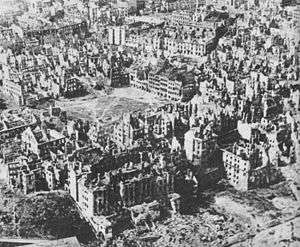
At the other end of Europe, the Waffen-SS was dealing with the Warsaw Uprising. Between August and October 1944, the Dirlewanger Brigade (recruited from criminals and the mentally ill throughout Germany) and the S.S. Sturmbrigade R.O.N.A. Russkaya Osvoboditelnaya Narodnaya Armiya (Russian National Liberation Army)[109] which was made up of ethnic Russian collaborators were both sent to Warsaw to put down the uprising. During the battle, the Dirlewanger behaved atrociously, raping, looting, and killing citizens of Warsaw regardless of whether they belonged to the Polish resistance or not; the unit commander SS-Oberführer Oskar Dirlewanger encouraged their excesses. The unit's behavior was reportedly so bestial and indiscriminate that Himmler was forced to send a battalion of SS military police to ensure the Dirlewanger convicts did not turn their aggressions against the leadership of the brigade or other nearby German units.[110] At the same time they were encouraged by Himmler to terrorize freely, take no prisoners, and generally indulge their perverse tendencies. Favoured tactics of the Dirlewanger men during the siege reportedly included the ubiquitous gang rape of female Poles, both women and children; playing "bayonet catch" with live babies; and torturing captives to death by hacking off their arms, dousing them with gasoline, and setting them alight to run armless and flaming down the street.[111][110] The Dirlewanger brigade committed almost non-stop atrocities during this period, in particular the four-day Wola massacre.

The other unit, Waffen-Sturm-Brigade R.O.N.A. was tasked with clearing the Ochota district in Warsaw that was defended by members of the Polish Home Army. Their attack was planned for the morning of 5 August, but when the time came, the RONA unit could not be found; after some searching by the SS military police, members of the unit were found looting abandoned houses in the rear of the German column. Later, thousands of Polish civilians were killed by the RONA SS men during the events known as Ochota massacre; many victims were also raped.[lower-alpha 2][lower-alpha 3] In following weeks, the RONA unit was moved south to the Wola district, but it fared no better in combat there than it did in Ochota; in one incident a sub-unit of the RONA brigade advanced to loot a captured building on the front line, but was subsequently cut off from the rest of the SS formation and wiped out by the Poles. Following the fiasco, SS-Brigadeführer Bronislav Vladislavovich Kaminski, the unit's commander, was called to Łódź to attend a SS leadership conference. He never arrived; official Nazi sources blamed Polish partisans for an alleged ambush that killed the RONA commander. But according to various other sources he was arrested and tried by the SS, or simply shot on the spot by the Gestapo. The behaviour of the RONA during the battle was an embarrassment even to the SS, and the alleged rape and murder of two German Strength Through Joy girls may have played a part in the eventual execution of the brigade's commander.[112]
Vistula River line
In late August 1944, 5 SS Wiking was ordered back to Modlin on the Vistula River line near Warsaw, where it was to join the newly formed Army Group Vistula. Fighting alongside the Luftwaffe's Fallschirm-Panzer Division 1 Hermann Göring, they annihilated the Soviet 3rd Tank Corps. The advent of the Warsaw Uprising brought the Soviet offensive to a halt, and relative peace fell on the front line. The division remained in the Modlin area for the rest of the year, grouped with the 3 SS Totenkopf in the IV SS Panzer Corps. Heavy defensive battles around Modlin followed for the rest of the year. Together they helped force the Red Army out of Warsaw and back across the Vistula River, where the Front stabilized until January 1945.
Ardennes Offensive
The Ardennes Offensive or "Battle of the Bulge", between 16 December 1944 and 25 January 1945, was a major German offensive through the forested Ardennes Mountains region of Belgium. The Waffen-SS units included the 6th Panzer Army under Sepp Dietrich. Created on 26 October 1944, it incorporated the I SS Panzer Corps (1 SS Leibstandarte, the 12 SS Hitlerjugend and the SS Heavy Panzer Battalion 101). It also had the II SS Panzer Corps (2 SS Das Reich and the 9 SS Hohenstaufen). Another unit involved was Otto Skorzeny's SS Panzer Brigade 150.
The purpose of the attack was to split the British and American line in half, capture Antwerp, and encircle and destroy four Allied armies, forcing the Western Allies to negotiate a peace treaty on terms favorable to the Axis Powers.[113] However, advancing through the forests and wooded hills of the Ardennes proved difficult in the winter weather. Initially the Germans made good progress in the northern end of its advance. However, they ran into unexpectedly strong resistance by the U.S. 2nd and 99th Infantry Divisions. By 23 December, weather conditions started improving, allowing the Allied air forces, which had been grounded, to attack. In increasingly difficult conditions, the German advance slowed.[114] The attack was ultimately a failure. Despite the efforts of the Waffen-SS and the German Army, the fuel shortages, stiff American resistance, including in and around the town of Bastogne and Allied air-assaults on German supply columns proved too much, costing the Germans 700 tanks and most of their remaining mobile forces in the west.[115] Hitler's failed counteroffensive had used most of Germany's remaining reserves of manpower and materiel, which could not be replaced.[116]

During the battle, Kampfgruppe Peiper, part of the 1 SS Leibstandarte, left a path of destruction, which included Waffen-SS men murdering American POWs and unarmed Belgian civilians.[117] It is infamous for the Malmedy massacre, in which approximately 90 unarmed American prisoners of war were murdered on 17 December 1944.[118] Also during this battle, 3./SS-PzAA1 LSSAH captured and shot eleven African-American soldiers from the American 333rd Artillery Battalion in the hamlet of Wereth. Their remains were found by Allied troops two months later. The soldiers had their fingers cut off and legs broken, and one was shot while trying to bandage a comrade's wounds.[119]
Siege of Budapest
In late December 1944, the Axis forces, including IX Waffen Mountain Corps of the SS (Croatian), defending Budapest, were encircled in the Siege of Budapest. The IV SS Panzer Corps (3 SS Totenkopf and 5 SS Wiking) was ordered south to join Hermann Balck's 6th Army (Army Group Balck), which was mustering for a relief effort code named Operation Konrad.
As a part of Operation Konrad I, the IV SS Panzer Corps was committed to action on 1 January 1945, near Tata, with the advance columns of Wiking slamming into the Soviet 4th Guards Army. A heavy battle ensued, with the 5 SS Wiking and 3 SS Totenkopf destroying many of the Soviet tanks. In three days their panzer spearheads had driven 45 kilometres, over half the distance from the start point to Budapest. The Red Army maneuvered forces to block the advance, halting them at Bicske, 28 kilometres (17 mi) from Budapest. Two further attacks, Operations Konrad II and III, also failed.[120]
The Hungarian Third Army was besieged in Budapest along with the IX Waffen Mountain Corps of the SS (Croatian) (8 SS Florian Geyer and 22 SS Maria Theresia). The siege lasted from 29 December 1944 until the city surrendered unconditionally on 13 February 1945. Only 170 men of the 22 SS Maria Theresia made it back to the German lines.
1945
1945 expansion
The Waffen-SS continued to expand in 1945. January saw the 32nd SS Volunteer Grenadier Division 30 Januar formed from the remnants of other units and staff from the SS-Junkerschules. In February the Waffen-Grenadier-Brigade der SS "Charlemagne" was upgraded to a division and became known as the 33rd Waffen Grenadier Division of the SS Charlemagne (1st French). At this time it had a strength of 7,340 men.[121] The SS Volunteer Grenadier-Brigade Landstorm Nederland was upgraded to the 34th SS Volunteer Grenadier Division Landstorm Nederland. The second SS Police division followed when the 35th SS and Police Grenadier Division was formed from SS Police units that had been transferred to the Waffen-SS. The Dirlewanger Brigade was reformed as the 36th Waffen Grenadier Division of the SS. There was now a real shortage of Waffen-SS volunteers and conscripts, so units from the Army were attached to bring it up to strength. The third SS Cavalry division 37th SS Volunteer Cavalry Division Lützow was formed from the remnants of the 8 SS Florian Geyer and 22 SS Maria Theresia, which had both been virtually destroyed. The last Waffen-SS division was the 38th SS Division Nibelungen, which was also formed from students and staff from the SS-Junkerschule, but consisted of only around 6,000 men, the strength of a normal brigade.
The XV SS Cossack Cavalry Corps, which contained the 1 SS Cossack Division, was transferred to the Waffen-SS on 1 February 1945. Despite the refusal of its commander, General von Pannwitz, to enter the SS, the corps was placed under SS administration and all Cossacks became formally part of the Waffen-SS.[122]
Operation Nordwind
Operation Nordwind was the last major German offensive on the Western Front. It began on 1 January 1945 in Alsace and Lorraine in north-eastern France, and it ended on 25 January. The initial attack was conducted by three Corps of the 1st Army. By 15 January at least 17 German divisions (including units in the Colmar Pocket) were engaged, including the XIII SS Army Corps (17 SS Götz von Berlichingen and 38 SS Nibelungen) and the 6 SS Nord and 10 SS Frundsberg.[123] At the same time, the Luftwaffe mounted a large offensive over the skies of France. Some 240 fighters were lost and just as many pilots. It was the 'last gasp' attempt for the Luftwaffe to take back air supremacy from the western allies.
Operation Solstice
Operation Solstice, or the "Stargard Tank Battle" (February 1945) was one of the last armoured offensive operations on the Eastern Front. It was a limited counter-attack by the three corps of the Eleventh SS Panzer Army, which was being assembled in Pomerania, against the spearheads of the 1st Belorussian Front. Originally planned as a major offensive, it was executed as a more limited attack. It was repulsed by the Red Army, but helped to convince the Soviet High Command to postpone the planned attack on Berlin.[124]
Initially the attack achieved a total surprise, reaching the banks of the Ina River and, on 17 January, Arnswalde. Strong Soviet counter-attacks halted the advance, and the operation was called off. The III (Germanic) SS Panzer Corps, was pulled back to the Stargard and Stettin on the northern Oder River.
East Pomeranian Offensive
The East Pomeranian Offensive lasted from 24 February to 4 April, in Pomerania and West Prussia. The Waffen-SS units involved were the 11 SS Nordland, 20 SS Estonian, 23 SS Nederland, 27 SS Langemark, 28 SS Wallonien, all in the III (Germanic) SS Panzer Corps, and the X SS Corps, which did not command any SS units.[125]
In March 1945, the X SS Corps was encircled by the 1st Guards Tank Army, 3rd Shock Army, and the Polish 1st Army in the area of Dramburg. This pocket was destroyed by the Red Army on 7 March 1945.[126][127] On 8 March 1945, the Soviet forces announced the capture of General Krappe and 8,000 men of the X SS Corps.[128]
Operation Spring Awakening

After the Ardennes offensive failed, in Hitler’s estimation, the Nagykanizsa oilfields southwest of Lake Balaton were the most strategically valuable reserves on the Eastern Front.[129] The SS Divisions were pulled out and refitted in Germany in preparation for Operation Spring Awakening (Frühlingserwachsen). Hitler ordered Dietrich’s 6th SS Panzer Army to take the lead and move to Hungary in order to protect the oilfields and refineries there.[130] The 6th SS Panzer Army was made up of the I SS Panzer Corps (1 SS Leibstandarte and 12 SS Hitlerjugend) and the II SS Panzer Corps (2 SS Das Reich and the 10 SS Frundsberg). Also present but not part of the 6th SS Panzer Army was the IV SS Panzer Corps (3 SS Totenkopf and 5 SS Wiking).
This final German offensive in the east began on 6 March. The German forces attacked near Lake Balaton with the Sixth SS Panzer Army advancing northwards towards Budapest and the 2nd Panzer Army moving eastwards and south.[131] Dietrich's army made "good progress" at first, but as they drew near the Danube, the combination of the muddy terrain and strong resistance of the Soviet forces ground them to a halt.[132] The overwhelming numerical superiority of the Red Army made any defense impossible, yet Hitler somehow had believed victory was attainable.[133]
After Operation Spring Awakening, the 6th SS Panzer Army withdrew towards Vienna and was involved what became known as the Vienna Offensive. The only major force to face the attacking Red Army was the II SS Panzer Corps (2 SS Das Reich and 3 SS Totenkopf), under the command of Wilhelm Bittrich, along with ad hoc forces made up of garrison and anti-aircraft units. Vienna fell to the Soviet forces on 13 April.[134] Bittrich's II SS Panzer Corps had pulled out to the west that evening to avoid encirclement.[135] The LSSAH retreated westward with less than 1,600 men and 16 tanks remaining.[136]
This failure is famous for the "armband order" that followed. The order was issued to the Sixth SS Panzer Army commander Sepp Dietrich by Adolf Hitler, who claimed that the troops, and more importantly, the 1 SS Leibstandarte, "did not fight as the situation demanded."[137] As a mark of disgrace, the Waffen-SS units involved in the battle were ordered to remove their treasured cuff titles. Dietrich did not relay the order to his troops.[132]
Berlin
The Army Group Vistula was formed in 1945 to protect Berlin from the advancing Red Army. It fought in the Battle of the Seelow Heights (16–19 April) and the Battle of Halbe (21 April – 1 May), both part of the Battle of Berlin. The Waffen-SS was represented by the III (Germanic) SS Panzer Corps.
On 23 April, Brigadeführer Wilhelm Mohnke was appointed by Hitler as Battle Commander for the centre government district (Zitadelle sector), which included the Reich Chancellery and Führerbunker. Mohnke's command post was in the bunkers under the Reich Chancellery.[138] He formed Kampfgruppe Mohnke (Battle Group Mohnke), divided into two weak regiments. It was made up of the LSSAH Flak Company, replacements from LSSAH Training and Reserve Battalion from Spreenhagan (under Standartenfuhrer Anhalt),[138] 600 men from the Begleit-Bataillon Reichsführer-SS,[139] the Führer-Begleit-Company, and the core group—800 men of the LSSAH Guard Battalion assigned to guard the Führer.[138]
The Reich Chancellery on 23 April ordered Brigadeführer Gustav Krukenberg to proceed to the capital with his men, who were reorganized as Sturmbataillon ("assault battalion") "Charlemagne". Between 320 and 330 French troops arrived in Berlin on 24 April after a long detour to avoid Soviet advance columns.[140] Krukenberg was also appointed the commander of (Berlin) Defence Sector C. This included the Nordland Division, whose previous commander, Joachim Ziegler, was relieved of his command the same day.[141] On 27 April, after a futile defence, the remnants of Nordland were pushed back into the centre government district (Zitadelle sector) in Defence sector Z. There Krukenberg's Nordland headquarters was a carriage in the Stadtmitte U-Bahn station.[142] The men of Nordland were now under Mohnke's overall command. Among the men were French, Latvian, and Scandinavian Waffen-SS troops.[143][144] Heavy artillery bombardment of the centre government district had began on 20 April 1945 and lasted until the end of hostilities. Under the intense shelling, the SS troops put up stiff resistance which led to bitter and bloody street fighting with the Soviet Red Army forces.[145] By 26 April, the Nordland defenders were pushed back into the Reichstag and Reich Chancellery. There over the next few days, the survivors (mainly French SS troops from the former 33 SS Charlemagne) held out against the Soviet army forces.[146]

On 30 April, after receiving news of Hitler's suicide, orders were issued that those who could do so were to break out. Prior to the breakout Mohnke briefed all commanders that could be reached within the Zitadelle sector about Hitler's death and the planned breakout.[147] The break out started at 2300 hours on 1 May. There were ten main groups that attempted to head northwest towards Mecklenburg. Fierce fighting continued all around, especially in the Weidendammer Bridge area. What was left of the 11 SS Nordland under Brigadeführer Krukenberg fought hard in that area, but the Soviet artillery, anti-tank guns and tanks destroyed the groups. Several very small groups managed to reach the Americans at the Elbe's west bank, but most, including Mohnke's group, could not make it through the Soviet rings.[147]

As for Reichsführer-SS Himmler, he attempted to go into hiding. He had equipped himself with a forged paybook under the name of Sergeant Heinrich Hitzinger and headed south on 11 May to Friedrichskoog. On 21 May, Himmler and two aides were detained at a checkpoint set up by former Soviet POWs and then handed over to the British Army. On 23 May, after admitting his real identity, a doctor attempted to examine him. However, Himmler bit into a hidden cyanide pill and collapsed onto the floor. He was dead within 15 minutes.[148][149]
Commanders
- Josef "Sepp" Dietrich was a former Army sergeant with a peasant background who commanded the forerunner of the Waffen-SS, the Sonderkommando Berlin. He would command the Leibstandarte SS Adolf Hitler from its inception to regiment, brigade, and division. He was then given command of the I SS Panzer Corps and by the end of the war was the commander of the 6th SS Panzer Army.[8]
- Paul Hausser, a former General in the regular army, was chosen by Himmler to transform the SS-VT into a credible military organisation. He was the first divisional commander of the Waffen-SS when the SS-VT was formed into a Division for the Battle of France. He went on to command the II SS Panzer Corps and the 7th Army.[18]
- Artur Phleps, a former Romanian general who joined the Waffen-SS, raised and commanded the 7th SS Volunteer Mountain Division Prinz Eugen then rose to command the V SS Mountain Corps which fought the Yugoslav Partisans.[150]
- Felix Steiner, another former army officer and veteran of World War I. He was given command of the SS Regiment Deutschland. He is credited with the creation of small mobile Battle Groups. He armed his men with Submachine guns and Grenades instead of rifles and issued camouflage clothing. He commanded the SS Division Wiking and the III (Germanic) SS Panzer Corps.[20]
Casualties
Total casualties amongst the Waffen-SS will probably never be known. One estimate indicates that they suffered 180,000 dead, 400,000 wounded, and 40,000 missing.[151] According to another source, 181,000 men were killed in action while 72,000 are missing in action, totaling approximately 253,000 casualties. That constitutes 25–28 per cent of the total strength of the Waffen SS.[lower-alpha 4]
War crimes

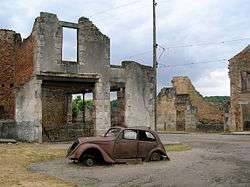
The separately organised Allgemeine SS was responsible for the administration of both the concentration and extermination camps. Many members of it and the SS-Totenkopfverbände subsequently became members of the Waffen-SS, forming the initial core of the 3rd SS Totenkopf Division.[25][34] A number of SS medical personnel who had Waffen-SS ties were also convicted of crimes during the "Doctors' trials" in Nuremberg, held between 1946 and 1947 for the Nazi human experimentation they performed at the camps.
In addition, many Waffen-SS members and units were responsible for war crimes against civilians and allied servicemen. After the war the SS organisation as a whole was held to be a criminal organization by the post-war German government, due to evidence that it was responsible for war crimes. Formations such as the Dirlewanger and Kaminski Brigades were singled out, and many others participated in large-scale massacres or smaller-scale killings such as murder of 34 captured allied servicemen ordered by Josef Kieffer during Operation Bulbasket in 1944, the Houtman affair,[152] or murders perpetrated by Heinrich Boere. The listed Waffen-SS units were responsible for the following massacres:
- Wormhoudt massacre by SS Leibstandarte Adolf Hitler, 1940, France[44]
- Le Paradis massacre by SS Division Totenkopf, 1940, France
- Pripyat swamps (punitive operation) by the SS Cavalry Brigade, 1941, USSR[153]
- Oradour-sur-Glane massacre by SS Division Das Reich, 1944, France
- Ochota massacre by SS Kaminski Brigade, 1944, Poland
- Wola massacre by SS-Sturmbrigade Dirlewanger, 1944, Poland
- Huta Pieniacka massacre by SS Division Galicia 1944, Poland
- Tulle massacre by SS Division Das Reich, 1944, France
- Graignes Massacre by SS Division Götz von Berlichingen, 1944, France
- Maillé massacre, also by SS Division Götz von Berlichingen, 1944, France
- Marzabotto massacre by 16th SS Panzergrenadier Division Reichsführer-SS, 1944, Italy
- Malmedy massacre by Kampfgruppe Peiper, part of 1st SS Panzer Division, 1944, Belgium
- Ardeatine massacre by two SS officers, 1944, Italy
- Distomo massacre by 4th SS Polizei Division, 1944, Greece
- Sant'Anna di Stazzema massacre by 16th SS Panzergrenadier Division Reichsführer-SS, 1944, Italy
- Ardenne Abbey massacre by 12th SS Panzer Division Hitlerjugend, 1944, France
The linking of the SS-VT with the SS-Totenkopfverbände (SS-TV) in 1938 raised important questions about Waffen-SS criminality,[21] since the SS-TV were already responsible for imprisonment, torture, and murder of Jews and other political opponents through providing the personnel for manning the concentration camps. Their leader, Theodor Eicke, who was the commandant of Dachau, inspector of the camps, and murderer of Ernst Röhm, later became the commander of the 3rd SS Totenkopf Division.[18] With the invasion of Poland, the Totenkopfverbände troops were called on to carry out so-called "police and security measures" in rear areas. What these measures entailed is demonstrated by the record of SS Totenkopf Standarte Brandenburg. It arrived in Włocławek on 22 September 1939 and embarked on a four-day "Jewish action" that included the burning of synagogues and the execution en masse of the leaders of the Jewish community. On 29 September the Standarte travelled to Bydgoszcz to conduct an "intelligentsia action". Approximately 800 Polish civilians and what the Sicherheitsdienst (SD) termed "potential resistance leaders" were killed. Later the formation became the 3rd SS Panzer Division Totenkopf, which one of the elite SS divisions, but from the start they were among the first executors of a policy of systematic extermination.

Waffen-SS formations were found guilty of war crimes, especially in the opening and closing phases of the war.[154] In addition to documented atrocities, Waffen-SS units assisted in rounding up Eastern European Jews for deportation and utilised scorched earth tactics during anti-partisan operations. Some Waffen-SS personnel convalesced at concentration camps, from which they were drawn, by serving guard duties. Other members of the Waffen-SS were more directly involved in genocide.[155]
The end of the war saw a number of war crime trials, including the Malmedy massacre trial. The counts of indictment related to the massacre of more than 300 American prisoners in the vicinity of Malmedy, between 16 December 1944 and 13 January 1945, and the massacre of 100 Belgian civilians mainly in the vicinity of Stavelot.[156]
During the Nuremberg Trials, the Waffen-SS was declared a criminal organisation,[154] except conscripts from 1943 onward, who were exempted from that judgement as they had been forced to join.
HIAG
HIAG (German: Hilfsgemeinschaft auf Gegenseitigkeit der Angehörigen der ehemaligen Waffen-SS, literally "Mutual aid association of former Waffen-SS members") was a lobby group and a revisionist veterans' organisation founded by former high-ranking Waffen-SS personnel in West Germany in 1951. It campaigned for the legal, economic and historical rehabilitation of the Waffen-SS, using contacts with political parties to manipulate them for its purposes.[157][158]
HIAG's historical revisionism encompassed multi-prong propaganda efforts, including periodicals, books and public speeches, alongside a publishing house that served as a platform for its publicity aims.[159][160] This extensive body of work – 57 book titles and more than 50 years of monthly periodicals – have been described by historians as revisionist apologia: [a] "chorus of self-justification";[161] "crucible of historical revisionism";[162] "false" and "outrageous" claims;[163] "most important works of [Waffen-SS] apologist literature" (in reference to books by Hausser and Steiner);[164] and "exculpating multi-volume chronicle" (in reference to the history of the SS Division Leibstandarte).[165]
Always in touch with its Nazi past, HIAG was a subject of significant controversy, both in West Germany and abroad.[157][158] The organisation drifted into right-wing extremism in its later history; it was disbanded in 1992 at the federal level, but local groups, along with the organisation's monthly periodical, continued to exist at least through the 2000s, possibly into the 2010s.[166][167]
While the HIAG leadership only partially achieved the goals of legal and economic rehabilitation of Waffen-SS,[168] falling short of their "extravagant fantasies about [Waffen-SS's] past and future",[169] HIAG's propaganda efforts have led to a reshaping of the image of Waffen-SS in popular culture.[159] The results are still felt, with scholarly treatments being drowned out by a "veritable avalanche of titles",[170] including amateur historical studies, memoirs, picture books, websites, and wargames.[171]
See also
- German war crimes
- Glossary of Nazi Germany
- List of Knight's Cross recipients of the Waffen-SS
- List of SS personnel
- List of Waffen-SS units
- List of Waffen-SS divisions
- ODESSA
- Signal Corps of the Wehrmacht and Waffen SS
- SS-Standarte Kurt Eggers
- SS and Police Leader
- Table of ranks and insignia of the Waffen-SS
- Uniforms and insignia of the Schutzstaffel
Explanatory notes
- ↑ Equivalent to a full General. The independence of the LSSAH can be partly explained by Dietrich's rank, as well as his personal friendship with Hitler.
- ↑ "Adolf Hitler is not interested in further existence of Warsaw ... the whole population shall be executed and all buildings blown up." Madajczyk 1972, p. 390.
- ↑ According to the evidence of Erich von dem Bach in Nürnberg, Himmler's order (issued on the strength of an order of Hitler), read as follows: "1. Caught razed insurgents shall be killed despite whether they fight in accordance with the Hague Convention or they infringe it. 2. Non-fighting part of population, women, children, shall also be killed. 3. All the city shall be razed to the ground, i.e. buildings, streets, facilities in that city, and everything which is within its borders." Wroniszewski 1970, pp. 128–129.
- ↑ According to a report from 12 July 1972 from the German bureau responsible for notifying next-of-kin of men killed in the former Wehrmacht, the total Waffen-SS casualties, including those who died in P.O.W. camps, amounted to 6 per cent of the entire German Armed Forces. That included 181,000 men killed and 72,000 missing in action, totaling approximately 253,000 casualties. That constitutes 25–28 per cent of the total strength of the Waffen SS. Wenn Alle Brűder Schweigen 2003.
References
Citations
- ↑ Stein 1984, pp. xxiv, xxv, 150, 153.
- ↑ McNab 2009, pp. 56, 57, 66.
- ↑ Reitlinger 1989, p. 84.
- ↑ Stein 1984, p. 23.
- ↑ Stackelberg 2002, p. 116.
- ↑ Langer & Rudowski 2008, p. 263.
- ↑ Król 2006, pp. 452, 545.
- 1 2 3 4 5 6 Flaherty 2004, p. 144.
- 1 2 Cook & Bender 1994, pp. 17, 19.
- ↑ Kershaw 2008, pp. 306–313.
- 1 2 3 4 Flaherty 2004, p. 145.
- ↑ Weale 2012, p. 202.
- ↑ Weale 2012, pp. 201–204.
- ↑ Weale 2010, p. 204.
- ↑ Longerich 2012, p. 220.
- ↑ Hastings 2013, pp. 7–8.
- ↑ Hastings 2013, pp. 11.
- 1 2 3 Flaherty 2004, p. 146.
- 1 2 3 4 5 Windrow & Burn 1992, pp. 7–8.
- 1 2 Flaherty 2004, p. 147.
- 1 2 3 Flaherty 2004, p. 148.
- ↑ Longerich 2012, pp. 500, 674.
- ↑ Longerich 2012, p. 769.
- ↑ Stein 1984, pp. 4–8, 27.
- 1 2 3 4 5 6 7 8 9 Flaherty 2004, p. 149.
- ↑ Stein 1984, pp. 27, 28, 33, 34.
- ↑ Stein 1984, pp. xxii, 35, 36.
- ↑ Stein 1984, p. 24.
- ↑ Butler 2001, p. 45.
- ↑ Rossino 2003, pp. 114, 159–161.
- ↑ Sydnor 1990, p. 37.
- ↑ Maria Wardzyńska (2009). Był rok 1939. Operacja niemieckiej policji bezpieczeństwa w Polsce. Intelligenzaktion [The year was 1939. Operation of German security police in Poland. Intelligenzaktion] (PDF file, direct download 2.56 MB) (in Polish). Institute of National Remembrance, IPN (Portal edukacyjny Instytutu Pamięci Narodowej). 8-10/356. ISBN 978-83-7629-063-8.
Oblicza się, że akcja „Inteligencja” pochłonęła ponad 100 tys. ofiar. Translation: It is estimated that Intelligenzaktion took the lives of 100,000 Poles.[p. 8, or 10 in PDF]
- ↑ Flaherty 2004, pp. 149–150.
- 1 2 Flaherty 2004, p. 150.
- ↑ Flaherty 2004, p. 151.
- 1 2 Flaherty 2004, p. 152.
- 1 2 3 4 5 Flaherty 2004, p. 154.
- ↑ Harman 1980, p. 100.
- ↑ Flaherty 2004, pp. 143, 154.
- 1 2 Flaherty 2004, p. 155.
- ↑ Cooper, D. (22 February 2004). "WW2 People's War: Le Paradis: The murder of 97 soldiers in a French field on the 26/27th May 1940". BBC Online. Retrieved 28 February 2016.
- ↑ Jackson 2001, pp. 285–288.
- ↑ Butler 2001, pp. 81–83.
- 1 2 Weale 2012, pp. 251–253.
- 1 2 Flaherty 2004, p. 143.
- ↑ Flaherty 2004, p. 156.
- ↑ Stein 1984, p. 102.
- ↑ Stein 1984, pp. 7, 103–106.
- ↑ Stein 1984, pp. 150, 153.
- 1 2 Flaherty 2004, pp. 160, 161.
- ↑ Evans 2008, p. 153.
- ↑ Flaherty 2004, p. 163.
- ↑ Flaherty 2004, pp. 162, 163.
- ↑ Weale 2012, p. 297.
- 1 2 3 4 Flaherty 2004, p. 165.
- ↑ Stein 1984, p. 104.
- 1 2 3 4 Windrow & Burn 1992, p. 9.
- 1 2 3 Flaherty 2004, p. 166.
- 1 2 3 Flaherty 2004, p. 168.
- 1 2 Hannes & Naumann 2000, p. 136.
- ↑ Browning 2007, p. 279.
- ↑ Pieper 2015, pp. 52–53.
- ↑ Pieper 2015, pp. 62, 80.
- ↑ Pieper 2015, p. 81.
- ↑ Browning 2007, p. 280.
- ↑ Cuppers 2006, p. 279.
- ↑ Pieper 2015, pp. 86, 88–89.
- ↑ Pieper 2015, pp. 119–120.
- ↑ Miller 2006, p. 310.
- ↑ Pieper 2015, p. 120.
- 1 2 3 Stein 1984, p. 171.
- ↑ Mitcham 2007, p. 148.
- 1 2 Reynolds 1997, p. 9.
- ↑ Fellgiebel 2000, p. 59.
- 1 2 Flaherty 2004, p. 173.
- ↑ Flaherty 2004, pp. 173–174.
- ↑ Margry 2001, p. 20.
- ↑ Reynolds 1997, p. 10.
- ↑ Stroop 1943.
- ↑ Holocaust Memorial Museum.
- ↑ Bergstrom 2007, p. 81.
- ↑ Fritz 2011, p. 350.
- ↑ Evans 2008, pp. 488–489.
- ↑ McNab 2009, pp. 68, 70.
- 1 2 3 4 Reynolds 1997, p. 15.
- ↑ Bishop & Williams 2003, p. 98.
- ↑ Thomson 2004.
- ↑ Stein 1984, pp. 184, 185, 194.
- ↑ Williamson & Andrew 2004, p. 4.
- ↑ Williamson & Andrew 2004, pp. 5–6.
- ↑ Zetterling & Frankson 2008, p. 335.
- ↑ Nash 2002, p. 366.
- ↑ Eyre 2006, pp. 343–376.
- ↑ Mitcham 2001, pp. 261–262.
- 1 2 Reynolds 1997, p. 131.
- ↑ Reynolds 1997, p. 145.
- ↑ Latimer 2001.
- ↑ Götz von Berlichingen Diary.
- ↑ Fey 2003, p. 145.
- ↑ Jarymowycz 2001, p. 196.
- ↑ Hastings 2006, p. 306.
- ↑ McGilvray 2005, p. 54.
- 1 2 Bercuson 2004, p. 233.
- ↑ BBC News 2003.
- ↑ Jewish Virtual Library, Sant'Anna massacre.
- ↑ BBC News 2007.
- ↑ Harclerode 2005, pp. 455–456.
- ↑ Ellis 2004, pp. 313–315.
- ↑ http://www.warsawuprising.com/paper/rona.htm
- 1 2 Bell 1966, pp. 89–91.
- ↑ Conot 1984, pp. 278–281.
- ↑ Kirchmayer 1978, p. 367.
- ↑ United States History.
- ↑ Weinberg 1994, p. 767.
- ↑ Weinberg 1994, pp. 767–769.
- ↑ Stein 1984, p. 232.
- ↑ Murray & Millett 2001, p. 468.
- ↑ Reynolds 2003.
- ↑ US Memorial Wereth.
- ↑ Zwack 1999.
- ↑ Littlejohn 1987, pp. 170, 172.
- ↑ Michaelis 2006, p. 36.
- ↑ 100th Division.
- ↑ Beevor 2002, p. 91.
- ↑ Raus 2005, pp. 324–332.
- ↑ Tessin 1973, p. 164.
- ↑ Ustinow 1981, p. 179.
- ↑ Schramm 1982, p. 1156.
- ↑ Duffy 2002, p. 293.
- ↑ Seaton 1971, p. 537.
- ↑ Duffy 2002, p. 294.
- 1 2 Stein 1984, p. 238.
- ↑ Ziemke 1968, p. 450.
- ↑ Ustinow 1981, pp. 238–239.
- ↑ Gosztony 1978, p. 262.
- ↑ McNab 2013, p. 280.
- ↑ Dollinger 1967, p. 198.
- 1 2 3 Fischer 2008, pp. 42–43.
- ↑ Stein 1984, p. 162.
- ↑ Forbes 2010, pp. 396–398.
- ↑ Beevor 2002, p. 301.
- ↑ Beevor 2002, p. 323.
- ↑ Stein 1984, p. 246.
- ↑ McNab 2013, pp. 328, 330, 338.
- ↑ Beevor 2002, pp. 365–367, 372.
- ↑ Weale 2012, p. 407.
- 1 2 Fischer 2008, p. 49.
- ↑ Bend Bulletin 1945.
- ↑ Longerich 2012, pp. 1–3.
- ↑ Stein 1984, p. 210.
- ↑ Windrow & Burn 1992, p. 10.
- ↑ Zimmermann 2004.
- ↑ Miller 2006, pp. 309, 310.
- 1 2 Stein 1984, p. 251.
- ↑ WBSTV 2007.
- ↑ US War Department 1948.
- 1 2 Large 1987.
- 1 2 Der Spiegel 2011.
- 1 2 MacKenzie 1997, pp. 135–141.
- ↑ Wilke 2011, pp. 398–399.
- ↑ MacKenzie 1997, p. 137.
- ↑ Picaper 2014.
- ↑ Diehl 1993, p. 225.
- ↑ Sydnor 1990, p. 319.
- ↑ Parker 2014, p. 217.
- ↑ Werther & Hurd 2014.
- ↑ Levenda 2014, p. 167.
- ↑ Diehl 1993, p. 236.
- ↑ Large 1987, p. 111–112.
- ↑ Wegner 1990, p. 1.
- ↑ Smelser & Davies 2008, p. 135.
Bibliography
- Ailsby, Christopher (2004). Hitler's Renegades: Foreign Nationals in the Service of the Third Reich. Brasseys. ISBN 1-57488-838-2.
- Association of Soldiers of the Former Waffen SS (2003) [1973]. Wenn Alle Brűder Schweigen. Coburg: Nation Europa Verlag GmbH. ISBN 3-920677-06-4.
- "Battle of the Buldge". Retrieved 2 June 2013.
- Beevor, Antony (2002). Berlin: The Downfall 1945. Viking-Penguin Books. ISBN 978-0-670-03041-5.
- Bell, Bowyer J (1966). Besieged: Seven Cities Under Siege. Chilton.
- Bercuson, David (2004) [1996]. Maple Leaf Against the Axis. Red Deer Press. ISBN 0-88995-305-8.
- Bergstrom, Christopher (2007). Kursk – The Air Battle: July 1943. Chervron/Ian Allen. ISBN 978-1-903223-88-8.
- Bishop, Chris; Williams, Michael (2003). SS: Hell on the Western Front. St Paul, Minn: MBI Publishing. ISBN 978-0-7603-1402-9.
- Browning, Christopher (2007). The Origins of the Final Solution: The Evolution of Nazi Jewish Policy, September 1939 – March 1942. University of Nebraska Press. ISBN 0-8032-5979-4.
- Butler, Rupert (2001). SS-Leibstandarte: The History of the First SS Division, 1934–45. Spellmount.
- Conot, Robert E. (1984). Justice at Nuremberg. Carrol & Graf.
- Cook, Stan; Bender, Roger James (1994). Leibstandarte SS Adolf Hitler: Uniforms, Organization, & History. San Jose, CA: R. James Bender. ISBN 978-0-912138-55-8.
- Cuppers, Martin (2006). Vorreiter der Shoah, Ein Vergleich der Einsätze der beiden SS-Kavallerieregimenter im August 1941 (in German). Meidenbauer Martin Verlag. ISBN 3-89975-080-2.
- Diehl, James M. (1993). Thanks of the Fatherland: German Veterans After the Second World War. Chapel Hill: University of North Carolina Press. ISBN 978-0-8078-2077-3.
- Dollinger, Hans (1967) [1965]. The Decline and Fall of Nazi Germany and Imperial Japan. New York: Bonanza. ISBN 978-0-517-01313-7.
- Duffy, Christopher (2002). Red Storm on the Reich: The Soviet March on Germany, 1945. Edison, NJ: Castle Books. ISBN 0-7858-1624-0.
- Ellis, L.F. (2004) [1968]. Butler, J. R. M., ed. Victory in the West, Volume II: The Defeat of Germany. History of the Second World War United Kingdom Military Series. Naval & Military Press. ISBN 1-84574-059-9.
- Evans, Richard J. (2008). The Third Reich at War. New York: Penguin. ISBN 978-0-14-311671-4.
- Eyre, Wayne (2006). "Operation RÖSSELSPRUNG and The Elimination of Tito, May 25, 1944: A Failure in Planning and Intelligence Support". Journal of Slavic Military Studies. Routledge, part of the Taylor & Francis Group. 19 (2): 343–376. doi:10.1080/13518040600697969.
- Fellgiebel, Walther-Peer (2000). Die Träger des Ritterkreuzes des Eisernen Kreuzes 1939–1945. Wölfersheim-Berstadt, Germany: Podzun-Pallas. ISBN 3-7909-0284-5.
- Fey, William (2003). Armor Battles of the Waffen-SS. Stackpole. ISBN 978-0-8117-2905-5.
- Fischer, Thomas (2008). Soldiers of the Leibstandarte. J.J. Fedorowicz. ISBN 978-0-921991-91-5.
- Flaherty, T. H. (2004) [1988]. The Third Reich: The SS. Time-Life. ISBN 1-84447-073-3.
- Forbes, Robert (2010) [2006]. For Europe: The French Volunteers of the Waffen-SS. Stackpole Books. ISBN 978-0-8117-3581-0.
- Fritz, Stephen (2011). Ostkrieg: Hitler's War of Extermination in the East. Lexington: The University Press of Kentucky. ISBN 978-0-81313-416-1.
- Gosztony, Peter (1978). Endkampf an der Donau 1944/45 (in German). Vienna: Molden Taschenbuch Verlag. ISBN 3-217-05126-2.
- "Götz von Berlichingen Diary". Retrieved 24 May 2013.
- "Greeks lose Nazi massacre claim". BBC News. 26 June 2003. Retrieved 2 June 2013.
- Hannes, Heer; Naumann, Klaus (2000). War of Extermination: The German Military in World War II 1941–1944. Berghahn. ISBN 1-57181-232-6.
- Harclerode, Peter (2005). Wings Of War – Airborne Warfare 1918–1945. Weidenfeld & Nicolson. ISBN 978-0-304-36730-6.
- Harman, Nicholas (1980). Dunkirk: The Necessary Myth. Hodder and Stoughton. ISBN 0-340-24299-X.
- Hastings, Max (2006) [1985]. Overlord: D-Day and the Battle for Normandy. Vintage. ISBN 0-307-27571-X.
- Hastings, Max (2013). Das Reich: The March of the 2nd SS Panzer Division through France, June 1944. Minneapolis USA: Zenith Press. ISBN 978-0-7603-4491-0.
- "Italy convicts Nazis of massacre". BBC News. 13 January 2007. Retrieved 2 June 2013.
- Jackson, Julian (2001). The Fall of France: The Nazi Invasion of 1940. Oxford University Press. ISBN 0-19-280550-9.
- Jarymowycz, Roman (2001). Tank Tactics: From Normandy to Lorraine. Lynne Rienner. ISBN 1-55587-950-0.
- Kershaw, Ian (2008). Hitler: A Biography. New York: W. W. Norton & Company. ISBN 978-0-393-06757-6.
- Kirchmayer, Jerzy (1978). Powstanie Warszawskie (in Polish). Książka i Wiedza. ISBN 83-05-11080-X.
- Król, Eugeniusz C. (2006). Polska i Polacy w propagandzie narodowego socjalizmu w Niemczech 1919–1945 (in Polish). Warsaw: Instytut Studiów Politycznych Polskiej Akademii Nauk. ISBN 978-83-7399-019-7.
- Langer, Howard J.; Rudowski, Marek (2008). Księga najważniejszych postaci II wojny światowej (in Polish). Warsaw: Bellona. ISBN 978-83-11-11111-0.
- Large, David C. (1987). "Reckoning without the Past: The HIAG of the Waffen-SS and the Politics of Rehabilitation in the Bonn Republic, 1950–1961". The Journal of Modern History. University of Chicago Press. 59 (1): 79–113. doi:10.1086/243161. JSTOR 1880378.
- Latimer, Jon (2001). "World War II: 12th SS Hitlerjugend Panzer Division Fought in Normandy". World War II (July). Retrieved 16 February 2009.
- Levenda, Peter (2014). The Hitler Legacy: The Nazi Cult in Diaspora: How it was Organized, How it was Funded, and Why it Remains a Threat to Global Security in the Age of Terrorism. Lake Worth, Fla.: Ibis Press. ISBN 978-0-89254-210-9.
- "Lawrenceville Man Admits Training Concentration Camp Attack Dogs". Cox Media Group. 2 October 2007. Retrieved 3 June 2013.
- Leland, Anne; Oboroceanu, Mari–Jana (2010). "American War and Military Operations Casualties: Lists and Statistics" (PDF). Congressional Research Service.
- Littlejohn, David (1987). Foreign Legions of the Third Reich Vol. 1 Norway, Denmark, France. Bender Publishing. ISBN 978-0912138176.
- Longerich, Peter (2012). Heinrich Himmler: A Life. Oxford; New York: Oxford University Press. ISBN 978-0-19-959232-6.
- MacKenzie, S.P. (1997). Revolutionary Armies in the Modern Era: A Revisionist Approach. New York: Routledge. ISBN 9780415096904.
- Madajczyk, Czesław (1972). Polityka III Rzeszy w okupowanej Polsce (in Polish). Warsaw: Państwowe Wydawnictwo Naukowe.
- Margry, Karel (2001). The Four Battles for Kharkov. Battle of Britain International. OCLC 254320761.
- McGilvray, Evan (2005). The Black Devil's March – A Doomed Odyssey: The 1st Polish Armoured Division 1939–1945. Helion & Company. ISBN 1-874622-42-6.
- McNab, Chris (2009). The SS: 1923–1945. Amber Books. ISBN 1-906626-49-9.
- McNab, Chris (2013). Hitler's Elite: The SS 1939–45. Osprey. ISBN 978-1-78200-088-4.
- Michaelis, Rolf (2006). Die Waffen-SS. Mythos und Wirklichkeit (in German). Berlin: Michaelis-Verlag.
- Miller, Michael (2006). Leaders of the SS and German Police, Vol. 1. San Jose, CA: R. James Bender. ISBN 978-93-297-0037-2.
- Mitcham, Samuel (2001). The Panzer Legions: A Guide to the German Army Tank Divisions of World War II and Their Commanders. Greenwood. ISBN 0-313-31640-6.
- Mitcham, Samuel (2007). German Order of Battle, Volume 3. Stackpole Books. ISBN 0-8117-3438-2.
- Murray, Williamson; Millett, Allan R. (2001). A War To Be Won: Fighting the Second World War. Harvard University Press. ISBN 978-0-67400-680-5.
- Nash, Douglas E. (2002). Hell's Gate: The Battle of the Cherkassy Pocket, January–February 1944. Southbury, Connecticut: RZM Publishing. ISBN 0-9657584-3-5.
- Staff (24 May 1945). "Heinrich Himmler Kills Himself in British Prison". Bend Bulletin. Retrieved 4 March 2016.
- War Crimes Office (1948). "Nazi Crimes on Trial: The Dachau Trials. Trials by U.S. Army Courts in Europe 1945 – 1948". U.S. Army Trial Reviews and Recommendations. United States War Department. Retrieved 3 June 2013.
- "Operation Nordwind in the Low Vosges 1–7 January 1945". Retrieved 2 June 2013.
- Overmans, Rűdiger (2000). Deutsche militärische Verluste im Zweiten Weltkrieg (in German). Munich: Oldenbourg. ISBN 3-486-56531-1.
- Parker, Danny S. (2014). Hitler's Warrior: The Life and Wars of SS Colonel Jochen Peiper. Boston: Da Capo Press. ISBN 978-0-306-82154-7.
- Picaper, Jean-Paul (2014). Les Ombres d'Oradour: 10 Juin 1944 [The Shadows of Oradour: 10 June 1944] (in French). Paris: Éditions l'Archipel. ISBN 978-2-8098-1467-5.
- Pieper, Henning (2015). Fegelein's Horsemen and Genocidal Warfare: The SS Cavalry Brigade in the Soviet Union. Houndmills, Basingstoke, Hampshire: Palgrave Macmillan. ISBN 978-1-137-45631-1.
- Raus, Erhard (2005). Panzer Operations. The Eastern Front Memoir of General Raus, 1941–1945. DeCapo.
- Reitlinger, Gerald (1989). The SS: Alibi of a Nation, 1922–1945. Da Capo. ISBN 978-0-306-80351-2.
- "Remembering the invisible soldiers of the Battle of the Bulge". U.S. Wereth Memorial. 2012. Retrieved 10 November 2013.
- Reynolds, Michael (1997). Steel Inferno: I SS Panzer Corps in Normandy. Spellmount. ISBN 1-873376-90-1.
- Reynolds, Michael (February 2003). "Massacre At Malmédy During the Battle of the Bulge". World War II Magazine.
- Ripley, Tim (2004). The Waffen-SS at War: Hitler's Praetorians 1925–1945. Zenith Imprint. ISBN 0-7603-2068-3.
- "The Sant'Anna di Stazzema Massacre (August 1944)". Jewish Virtual Library. Retrieved 2 June 2013.
- Rossino, Alexander B. (2003). Hitler Strikes Poland: Blitzkrieg, Ideology, and Atrocity. Lawrence, Kansas: University Press of Kansas. ISBN 0-7006-1234-3.
- Schramm, Percy E. (1982). Kriegstagebuch des Oberkommandos der Wehrmacht 1944–1945 Teilband II (in German). Herrsching: Manfred Pawlak.
- Seaton, Albert (1971). The Russo-German War, 1941–45. New York: Praeger Publishers. ISBN 978-0-21376-478-4.
- Smelser, Ronald; Davies, Edward J. (2008). The Myth of the Eastern Front: The Nazi-Soviet War in American Popular Culture. New York: Cambridge University Press. ISBN 978-0-521-83365-3.
- "The Brown Bluff: How Waffen SS Veterans Exploited Postwar Politics". Der Spiegel. 2011. Archived from the original on 2015-12-01. Retrieved 1 December 2015.
- Stackelberg, Roderick (2002). Hitler's Germany: Origins, Interpretations, Legacies. London; New York: Taylor & Francis. ISBN 978-0-203-00541-5.
- Stein, George (1984) [1966]. The Waffen-SS: Hitler's Elite Guard at War 1939–1945. Ithaca, N.Y.: Cornell University Press. ISBN 978-0-8014-9275-4.
- Stroop, Jürgen (1943). "The Stroop Report: The Warsaw Ghetto Is No More". Jewish Virtual Library. Retrieved 24 May 2013.
- Sydnor, Charles W. (1990) [1977]. Soldiers of Destruction: The SS Death's Head Division, 1933–1945. Princeton, N.J.: Princeton University Press. ISBN 978-0-691-00853-0. Retrieved 2016-01-08.
- Tessin, Georg (1973). Verbände und Truppen der deutschen Wehrmacht und Waffen-SS 1939–1945, Volumes II and III (in German). Biblio Verlag.
- Thomson, Mike (23 September 2004). "Hitler's secret Indian army". BBC News. Retrieved 24 May 2013.
- "Jewish Uprisings in Ghettos and Camps, 1941–1944: Resistance in Ghettos". United States Holocaust Memorial Museum. Retrieved 28 May 2013.
- Ustinow, D. F (1981). Geschichte des zweiten Weltkrieges 1939–1945 (in German). X. Berlin: Militärverlag der Deutschen Demokratischen Republik.
- Weale, Adrian (2010). The SS: A New History. Little, Brown. ISBN 978-1-4087-0304-5.
- Weale, Adrian (2012). Army of Evil: A History of the SS. New York: Caliber Printing. ISBN 978-0-451-23791-0.
- Wegner, Bernd (1990). The Waffen-SS: Organization, Ideology and Function. Blackwell. ISBN 0-631-14073-5.
- Weinberg, Gerhard (1994). A World at Arms: A Global History of World War II. Cambridge; New York: Cambridge University Press. ISBN 0-521-44317-2.
- Werther, Steffen; Hurd, Madeleine (2014). "Go East Old Man: The Ritual Spaces of SS Veteran's Memory Work" (PDF). Culture Unbound. Journal of Current Cultural Research. 6: 327–359. doi:10.3384/cu.2000.1525.146327. Archived (PDF) from the original on 2 January 2016.
- Williamson, Gordon; Andrew, Stephan (2004). The Waffen-SS (4): 24. To 38. Divisions, & Volunteer Legions. Osprey. ISBN 1-84176-589-9.
- Windrow, Martin; Burn, Cristopher (1992). The Waffen-SS, Edition 2. Osprey. ISBN 0-85045-425-5.
- Wroniszewski, Józef (1970). Ochota 1944 (in Polish). Warsaw: Wydawnictwo Ministerstwa Obrony Narodowej.
- Zetterling, Niklas; Frankson, Anders (2008). The Korsun Pocket: The Encirclement and Breakout of a German Army in the East, 1944. Philadelphia: Casemate. ISBN 978-1-932033-88-5.
- Ziemke, Earl F. (1968). Stalingrad to Berlin: The German Defeat in the East. Washington: Office of the Chief of Military History – U.S. Army. ASIN B002E5VBSE.
- Zimmermann, Elizabeth (21 January 2004). "Former SS member faces trial for war crimes in the Netherlands". World Socialist Web Site. International Committee of the Fourth International. Retrieved 3 June 2013.
- Zwack, Peter (1999). "World War II: Siege of Budapest". Quarterly Journal of Military History.
Further reading
- Clark, Lloyd (2004). Operation Epsom. Battle Zone Normandy. History Press. ISBN 0-7509-3008-X.
- Lasik, Aleksander (2007). Sztafety Ochronne w systemie niemieckich obozów koncentracyjnych. Rozwój organizacyjny, ewolucja zadań i struktur oraz socjologiczny obraz obozowych załóg SS [Schutzstaffel of the NSDAP in the System of German Concentration Camps; Organizational Development, Evolution of Goals, Structure, and Social Picture of SS Staff] (in Polish). Auschwitz-Birkenau: Państwowe Muzeum. ISBN 83-60210-32-2.
- Wiesenthal, Simon; Wechsberg, Joseph (1967). The Murderers Among Us: The Simon Wiesenthal Memoirs. McGraw-Hill. LCN 67-13204.
- Wilke, Karsten (2011). Die "Hilfsgemeinschaft auf Gegenseitigkeit" (HIAG) 1950–1990: Veteranen der Waffen-SS in der Bundesrepublik [HIAG 1950–1990: Waffen-SS veterans in the Federal Republic] (in German). Paderborn: Schoeningh Ferdinand GmbH. ISBN 978-3-506-77235-0.
External links
-
 Media related to Waffen-SS at Wikimedia Commons
Media related to Waffen-SS at Wikimedia Commons
